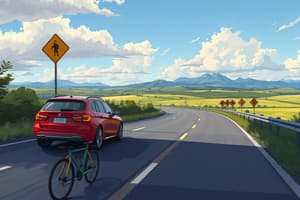Podcast
Questions and Answers
Which term refers to the protective gear worn on the head during hazardous activities?
Which term refers to the protective gear worn on the head during hazardous activities?
- Badge
- Knee pad
- Helmet (correct)
- Seat belt
What is the best action to take when approaching an intersection to ensure safety?
What is the best action to take when approaching an intersection to ensure safety?
- Speed up to clear the intersection quickly
- Pay attention to traffic signs (correct)
- Aggressively tailgate the vehicle in front
- Swerve around obstacles
Which condition is most likely to increase the risk of a vehicle crash?
Which condition is most likely to increase the risk of a vehicle crash?
- Using turn signals
- Being drowsy (correct)
- Driving carefully
- Maintaining a safe distance
When encountering a snowstorm, what should a driver do to prevent accidents?
When encountering a snowstorm, what should a driver do to prevent accidents?
What should be avoided to reduce the likelihood of injury while driving?
What should be avoided to reduce the likelihood of injury while driving?
Wearing a ______ can protect your head during construction work.
Wearing a ______ can protect your head during construction work.
In the middle of a ______, visibility can be greatly reduced.
In the middle of a ______, visibility can be greatly reduced.
When driving at high speed, it's important to ______ other vehicles.
When driving at high speed, it's important to ______ other vehicles.
The athlete suffered a ______ after falling during the game.
The athlete suffered a ______ after falling during the game.
It is crucial to ______ in order to ensure your own safety while driving.
It is crucial to ______ in order to ensure your own safety while driving.
Flashcards
Risk
Risk
The possibility of something bad happening.
Avoid
Avoid
To keep away from something.
Speed
Speed
How fast something is moving.
Injury
Injury
Signup and view all the flashcards
Intersection
Intersection
Signup and view all the flashcards
Obey traffic laws
Obey traffic laws
Signup and view all the flashcards
Distracted driving
Distracted driving
Signup and view all the flashcards
Aggressive driving
Aggressive driving
Signup and view all the flashcards
Drowsy driving
Drowsy driving
Signup and view all the flashcards
Encounter
Encounter
Signup and view all the flashcards
Study Notes
Road Safety
- Driving Behaviors: Aggressive driving, cautious driving, distracted driving, drowsy driving, rude driving, are all factors influencing the likelihood of accidents.
- Safety Equipment: Wearing a helmet, using knee pads, and utilizing a seatbelt are crucial for reducing the risk of injuries in a crash.
- Environmental Factors: Adverse weather conditions like snowstorms and fog can increase the risk of accidents.
- Collision Avoidance Techniques: Adjusting speed, avoiding tailgating, weaving through traffic, paying close attention, obeying traffic laws, and misjudging situations will lead to accidents..
- Collision Prevention: Preventing collisions can be achieved by releasing the gas pedal, avoiding abrupt stops and starts, braking steadily, and swerving only as a last resort.
- Consequences of Accidents: A crash can result in injuries including burns, cuts, fractures, and even death. Skids, slips, and sprains are also potential outcomes of accidents.
Injury Types
- Physical Injuries: A crash can lead to various injuries like fractures, burns, cuts, and other physical harm.
- Severity of Injury: Injuries can range from minor to severe, potentially leading to unconsciousness.
Terms Related to Driving and Accidents
- Crash: A collision between vehicles
- Intersection: A place where roads meet
- Risk: Probability of an accident occurring
- Shock: A medical condition that can result from a serious accident.
- Ostrich: is an unrelated term, so not related to driving
- Injury: Physical damage resulting from an accident.
- Equipment: Objects that improve safety or performance, like helmets or knee pads.
Actions
- Adjust: Modifying speed or position
- Avoid: Stopping something from happening
- Encounter: Coming into contact with
- Misjudge: Incorrectly assessing a situation
- Obey: Following rules
- Occur: To happen
- Prevent: Stopping something from happening
- Release: Letting go, such as of the gas pedal
- Skid: Losing control of a vehicle on a surface
- Swerve: Changing the direction of a vehicle quickly
- Speed: Rate of travel of a vehicle
- Tailgate: Driving too closely behind another vehicle
- Weave: Changing lanes frequently, or moving through traffic
- Break: Applying the brakes
- Burn: A severe injury caused by heat
- Cut: A laceration
- Die: Loss of life
- Fracture: A broken bone
Studying That Suits You
Use AI to generate personalized quizzes and flashcards to suit your learning preferences.




